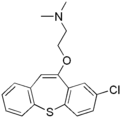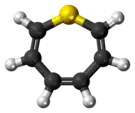Thiepine
In organic chemistry, thiepine (or thiepin) is an unsaturated seven-membered heterocyclic compound, with six carbon atoms and one sulfur atom. The parent compound, C6H6S is unstable and is predicted to be antiaromatic. Bulky derivatives have been isolated and shown by X-ray crystallography to have nonplanar C6S ring.[1]
| |||
| Names | |||
|---|---|---|---|
| Preferred IUPAC name
Thiepine | |||
| Other names
Thiatropilidene Thiepin | |||
| Identifiers | |||
3D model (JSmol) |
|||
| ChemSpider | |||
PubChem CID |
|||
| UNII | |||
CompTox Dashboard (EPA) |
|||
| |||
| |||
| Properties | |||
| C6H6S | |||
| Molar mass | 110.17 g·mol−1 | ||
Except where otherwise noted, data are given for materials in their standard state (at 25 °C [77 °F], 100 kPa).
Infobox references | |||
Theoretical studies suggest that thiepine would eliminate a sulfur atom to form benzene. The intermediate is this process is the bicycle thianorcaradiene. In the complex with (η4-C6H6S)Fe(CO)3, the ring is stable.[2]
Benzothiepines have one fused benzene group and dibenzothiepines such as dosulepin and zotepine have two fused benzene groups. Damotepine is another thiepin derivative.

The chemical structure of the dibenzothiepine zotepine.
References
- Schwan, A. L., "Thiepins" Science of Synthesis, 2004, volume 17, 705. doi:10.1055/sos-SD-017-01065
- Nishino, K.; Takagi, M.; Kawata, T.; Murata, I.; Inanaga, J.; Nakasuji, K., "Thiepine-iron tricarbonyl: stabilization of thermally labile parent thiepine by transition metal complexation", J. Am. Chem. Soc. 1991, volume 113, 5059-5060.
External links
- Thiepins at the U.S. National Library of Medicine Medical Subject Headings (MeSH)
- Benzothiepins at the U.S. National Library of Medicine Medical Subject Headings (MeSH)
This article is issued from Wikipedia. The text is licensed under Creative Commons - Attribution - Sharealike. Additional terms may apply for the media files.

